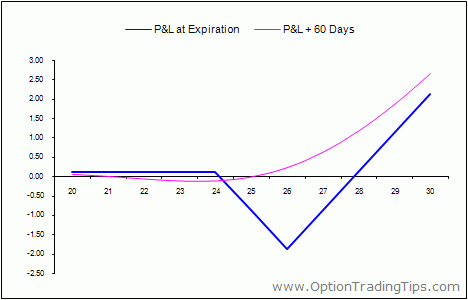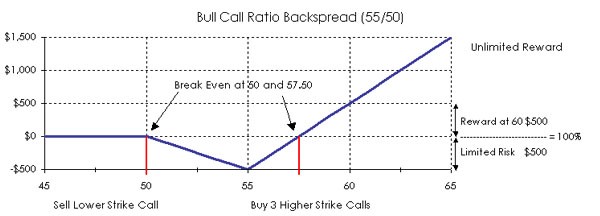Call Ratio Backspread
Post on: 28 Июль, 2015 No Comment

Outlook: Bullish and expecting a breakout
Unlike the comparatively timid long call spread, the call ratio backspread is engineered to capitalize on a breakout bullish move in the underlying stock. The trade combines sold and purchased call options in such a manner as to limit risk, while leaving open the possibility of theoretically unlimited profit potential.
To understand how this bullish stock/bullish volatility options strategy works, lets check out an example of a call ratio backspread.
Entering the Trade
After a strong run higher, Stock XYZ has spent the past several weeks consolidating around $25. You expect the shares to break out of this tight pattern soon, with another big upside move on the horizon.
To implement a call ratio backspread, you sell to open one in-the-money 22.50-strike call at the bid price of 2.68, and simultaneously buy to open two out-of-the-money 27.50-strike calls for the ask price of 0.40. You collected 2.68 on the sale of the lower-strike call, and spent 0.80 (0.40 x 2) to buy the higher-strike calls resulting in a net credit of 1.88. Multiplied by 100 shares per contract, youve collected $188 just for entering the trade.
Potential Gains
In the best-case scenario, XYZ will rally well above the strike price of your purchased calls prior to expiration.
Your upper breakeven point is calculated by taking the difference between the two call strikes and adding that amount to the upper call strike, less your net credit. In this case, thats [(27.50 22.50) + 27.50 1.88] = 30.62. With the shares at $30.62, your net credit (1.88) and the intrinsic value of your two purchased calls (3.12 x 2 = 6.24) will be sufficient to offset the intrinsic value of your sold call (8.12).
Therefore, on any move above $30.62, your profits will begin to add up. Since theres no cap to how high the stock can rally, gains are theoretically unlimited from here.
Plus, even if XYZ completely defies your expectations and plummets below the sold call strike prior to expiration, you can still keep the initial net credit as your profit.
Potential Losses

Losses begin to mount if XYZ settles anywhere between breakeven on the sold call which is equivalent to the strike price plus net credit, or 22.50 + 1.88 = 24.38 and the purchased call strike at 27.50.
The worst-case scenario for a call ratio backspread is for the shares to settle right at the upper call strike of 27.50. In this case, your maximum loss is equal to the difference between the two strikes, less the net credit or [(27.50 22.50) 1.88] = 3.12. Accounting for 100 shares per contract, you could lose up to $312 on the spread.
Volatility Impact
Despite the combination of sold and purchased calls in the call ratio backspread, you generally want to see implied volatility rise once youve entered the trade. While your sold call will become more expensive, the values of your two purchased calls will also increase.
Other Considerations
The call ratio backspread can also be constructed using different ratios, such as 3:2 or 5:3.
Additionally, depending upon the strike selection and the ratio of calls used, the call ratio backspread may be entered for a net debit, as opposed to a credit. In this case, the maximum loss is equivalent to the difference between the two strikes plus the net debit. Profits will begin to accrue after the stock surmounts breakeven, which is equal to the strike price of the purchased calls plus the maximum potential loss.














